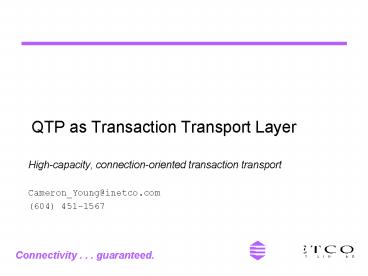QTP as Transaction Transport Layer - PowerPoint PPT Presentation
1 / 8
Title:
QTP as Transaction Transport Layer
Description:
High availability. Security. Restrict by source access network address ... Released as Internet Draft: draft-cornish-qtp-01.txt. First applications in production ... – PowerPoint PPT presentation
Number of Views:44
Avg rating:3.0/5.0
Title: QTP as Transaction Transport Layer
1
QTP as Transaction Transport Layer
- High-capacity, connection-oriented transaction
transport - Cameron_Young_at_inetco.com
- (604) 451-1567
2
Introduction
- Who is INETCO?
- Software vendor linking institutions with
terminals - See www.inetco.com
- Our perspective
- Financial/retail vertical market
- Financial TP is often Most mission critical
application - We make new elements evolving into a system
communicate with what is already there. - Normally we work in all layers below ISO8583 or
equivalent message.
- Why are we here?
- Joint authors of QTP - transport protocol for POS
transactions over IP. - SOAP/HTTP emphasizes client-web-server
interaction. QTP addresses concentration points
(back-end). - Scope
- Deal with communication issues, not use of RPC
vs. Message API.
3
Typical POS Architecture
Network Access Controllers or FEP
POS Terminals (1000s to 100ks)
Institutions EFT TPs
X.25/Dial Access Network
SNA/X.25/FR Access Network
Message
Message (ISO8583 or other)
Visa, TPDU, CLNP, TPDU
Visa, TPDU, CLNP, None
X.25, FR, IP
HDLC, X.25, Async
4
Transport Layer Requirements
- Performance
- Fast connection processing
- High availability
- Security
- Restrict by source access network address
- Restrict by source transport-layer address
- Restrict RAS - INAC communication
- Provide legal intercept
- Transaction delivery
- Either non-reliable delivery, or
- Reliable delivery with end-to-end data
acknowledgements
- Access Network independence
- X.25, FR, Dialup, ...
- Transport layer independence
- TCP or UDP, FR, other
- Scaling
- gt100k transaction terminals
- gt100 financial institutions
- Initial peak 500 TPS with scalable growth
5
IP-oriented Architecture
INAC clusters
Remote Access Servers
POS Terminals
Institution EFT TPs
IP Network
X.25/Dial Access Network
SNA/X.25/FR Access Network
Message (as is)
Message (as is)
Message (ISO8583 or other)
Transport (as is)
Host transport
Visa, TPDU, CLNP, None
QTP
X.25, SNA, FR
HDLC, X.25, Async
UDP/IP
6
QTP Overview
- Status
- Released as Internet Draft
- draft-cornish-qtp-01.txt
- First applications in production
- Incorporated by other vendors.
- Opensource version available for
draft-cornish-qtp-00.txt - Characteristics
- Lightweight connection multiplexing
- Symmetric
- Individual message acks
- Status for source routing decisions.
- Independent of lower-level transport
- Attribute/Value based
- Extensible
- Header
- Version
- Msg ID, Msg ID Ack, Priority flags
- Length
- Src / Dest Logical Channel Number
- Optional Msg ID, Msg ID Ack values
- Attributes for
- Session establishment
- Data transfer
- Session management
- Element status
- Statistical information
- Vendor extensions
7
QTP Attributes
- Session Establishment
- Called / Calling party addresses
- Called / Calling party subaddresses
- Address family (E.164, X.121, )
- Profile, speed, idle timeout
- Max message
- Protocol identifier
- Customer group identifier
- Data Transfer
- Data / Block data
- Management info
- Q Data / Call Data
- Session Management
- Cause (Normal, various QTP causes)
- Remote cause (Normal, various Access causes)
- Element Status
- Flow control state (Available, Congested)
- Station status (Primary, Secondary, )
- Ping
- Call state
- Statistical Information
- Messages received / sent
- Unacked messages
- Time since last restart
8
Closing Comments
- QTP not a fit for client side, unless client is
really a gateway / proxy for many transaction
generators. - Primary incentive for choosing QTP today is
scaling beyond TCP session limits. QTP addresses
concentrated connection-oriented transactions. - May be future interest in SOAP over QTP.
- Would require split into SOAP encapsulation and
SOAP over HTTP specs. - As transaction concentration increases, so does
emphasis on security, reliability, and
performance.































